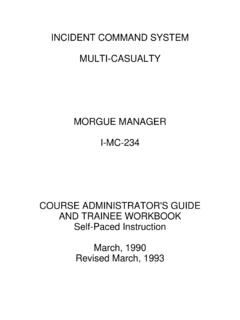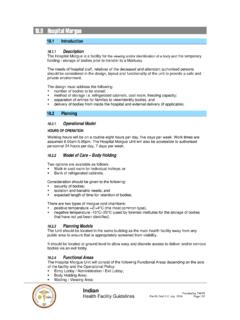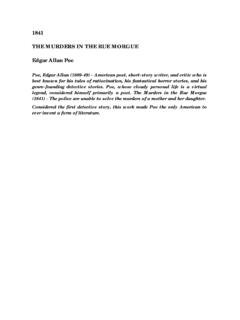Transcription of Findings and Recommendations: MORTUARY
1 Office of the Chief Medical Examiner September 2003 54 Findings and recommendations : MORTUARY MORTUARY Office of the Chief Medical Examiner September 2003 55 MORTUARY 1 19. OCME s death pronouncement process does not ensure that bodies are always 2 officially pronounced dead prior to arrival at OCME. 3 Death Pronouncements Are Not Always Timely 4 Establishing and following proper procedures regarding the official pronouncement of 5 death ensures that this important step occurs without delay and is done in accordance with 6 accepted medical standards. The Department of Justice s National Guidelines for Death 7 Investigations recommend that appropriate and qualified personnel make a determination of 8 death prior to the medical examiner assuming responsibility for a case.
2 NAME recommends that 9 the CME arrange for a formal pronouncement of death prior to a body arriving at the medical 10 examiner s office. 11 12 Following the national guidelines reduces delays in official pronouncements of death, 13 allows the time of death to be accurately documented on death certificates, and aids in 14 investigating the cause of death in criminal cases. In addition, adhering to proper death 15 pronouncement procedures ensures that persons who are believed to have signs of life (such an 16 allegation was the subject of a previous OIG report) are not brought to OCME where no 17 resuscitative equipment is available.
3 18 19 The team found that under current operational practices, official pronouncements of death 20 by OCME in the District are often delayed because of a lack of qualified employees. The CME, 21 a medical examiner, physicians, physician s assistants, MLIs, and advanced practice registered 22 nurses can officially pronounce death, but are often not available, particularly after normal duty 23 hours. If none of these individuals can go to the death scene, OCME autopsy technicians may 24 transport a body to the MORTUARY prior to the pronouncement of death. Consequently, bodies 25 arriving during evening hours or on weekends may not be pronounced dead for several hours 26 until a qualified person is available.
4 27 28 Surrounding jurisdictions allow physicians, physicians assistants, paramedics, and nurse 29 practitioners with 4 years of experience to pronounce death. District regulations, however, do 30 not allow trained paramedics to pronounce death even though they are often the first on the 31 scene. Surrounding jurisdictions also contract with private physicians to go to death scenes 32 outside of medical facilities and nursing homes to pronounce death when needed. 33 34 OCME autopsy technicians stated that in the past, they transported bodies to a medical 35 emergency room for the pronouncement of death prior to arriving at OCME, but this is no longer 36 done.
5 37 38 recommendations : 39 40 a. That the CME consider contracting with private physicians to pronounce death at 41 the scene when no qualified personnel are available. 42 43 Agree Disagree X 44 MORTUARY Office of the Chief Medical Examiner September 2003 56 b. That the CME consider resumption of the practice of having autopsy technicians 1 transport bodies to an emergency room for the pronouncement of death prior to 2 arrival at OCME when no qualified personnel are available. 3 4 Agree X Disagree 5 c. That the CME consult with OCC on proposing legislation to the Council that 6 would permit qualified paramedics to officially pronounce death.
6 7 8 Agree X Disagree 9 CME's comments regarding Page 55, Line 33, as received: 10 11 These are fundamentally different ME systems. This statement misrepresents the 12 functions of these contracted physicians. They are not hired to pronounce bodies; they function 13 as field investigators in geographically large and organizationally decentralized systems. In 14 addition to reservations about such an arrangement based on professional standards and 15 experiences in other jurisdictions, it is not particularly relevant to the conditions in the District of 16 Columbia. 17 18 OIG Response: The team found that contract physicians in Fairfax, VA pronounce 19 death, and contract physicians in Baltimore pronounce and investigate deaths.
7 20 21 CME's comments regarding Page 55, Line 37, as received: 22 23 It is no longer done because the hospitals generally refuse to do it, not because of a 24 change of OCME policy. I have raised this issue with the DC Hospital Association. 25 20. The lack of procedures, training, and equipment for efficient body handling and 26 transport puts employees at risk. 27 No Procedures Developed for Body Handling and Transport 28 OCME transports decedents from a variety of death scenes. NAME recommends that all 29 medical examiner offices have written policies and procedures for body handling and transport. 30 These policies and procedures instruct transportation employees on the equipment needed and 31 proper chain of custody procedures during the transportation process.
8 They also instruct 32 employees in the manner of transporting and handling bodies that will be most respectful to the 33 decedent and the next of kin. Written policies, procedures, and training should also instruct staff 34 on the best body handling methods to avoid injuries when lifting and transferring bodies from 35 stretchers and carts. 36 37 OCME does not have written policies and procedures or training covering body handling 38 and transportation to assure that decedents will be handled and transported respectfully, and that 39 employees will use safe handling techniques to avoid mishap and personal injury. In addition, 40 autopsy assistants responsible for body handling and transport stated that they have not been 41 provided with any formal training in this area and have sustained injuries handling and 42 transporting bodies.
9 The CME stated that he has not had time to establish written polices and 43 procedures for body handling and MORTUARY Office of the Chief Medical Examiner September 2003 57 Recommendation: 1 2 That the CME establish written policies and procedures and provide training for body 3 handling and transport. 4 5 Agree X Disagree 21. The procedures for processing bodies into the morgue are inadequate. 6 Body Intake Processing Procedures Are Insufficient 7 According to best practices followed in surrounding jurisdictions, medical examiner 8 offices have written policies and procedures for processing of bodies into the morgue that 9 include a checklist maintained with the decedent s case file to ensure that all necessary steps are 10 taken.
10 The procedures include weighing the body, photographing, fingerprinting, documenting 11 the time of arrival, and tagging the body with an identification number. 12 13 OCME has only verbal procedures for processing bodies into the morgue. The team 14 noted there is no checklist for autopsy technicians to follow to ensure that all steps of the check-15 in process are completed, and only a handwritten log is made of intake information. The team 16 found that many of the steps in the verbal process are sometimes overlooked, such as logging in 17 the time and date of arrival, and photographing and fingerprinting the body. 18 19 Recommendation: 20 21 That the CME establish written policies and procedures for processing bodies into the 22 morgue, including a checklist to be maintained with a decedent s case file.









